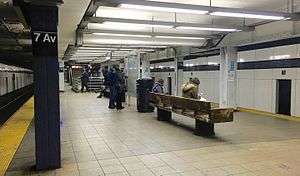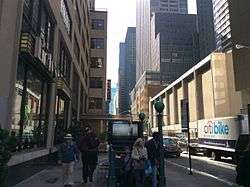Seventh Avenue (IND lines)
7 Avenue | |||||||||
|---|---|---|---|---|---|---|---|---|---|
|
| |||||||||
 Upper Level platform | |||||||||
| Station statistics | |||||||||
| Address |
Seventh Avenue & West 53rd Street New York, NY 10019 | ||||||||
| Borough | Manhattan | ||||||||
| Locale | Midtown Manhattan | ||||||||
| Coordinates | 40°45′47″N 73°58′55″W / 40.762959°N 73.981891°WCoordinates: 40°45′47″N 73°58′55″W / 40.762959°N 73.981891°W | ||||||||
| Division | B (IND) | ||||||||
| Line |
IND Sixth Avenue Line IND Queens Boulevard Line | ||||||||
| Services |
B D E | ||||||||
| Transit connections |
| ||||||||
| Structure | Underground | ||||||||
| Levels | 2 | ||||||||
| Platforms |
2 island platforms (1 on each level) cross-platform interchange | ||||||||
| Tracks | 4 (2 on each level) | ||||||||
| Other information | |||||||||
| Opened | August 19, 1933 | ||||||||
| Station code | 277[1] | ||||||||
| Accessibility | Cross-platform wheelchair transfer available | ||||||||
| Wireless service |
| ||||||||
| Former/other names | Seventh Avenue–53rd Street | ||||||||
| Traffic | |||||||||
| Passengers (2017) |
5,105,535[3] | ||||||||
| Rank | 90 out of 425 | ||||||||
| Station succession | |||||||||
| Next east |
↑ Fifth Avenue/53rd Street (Queens Blvd): E ↓ 47th–50th Streets–Rockefeller Center (6th Ave): B | ||||||||
| Next west |
↑ 59th Street–Columbus Circle (6th Ave): B ↓ 50th Street (Queens Blvd): E | ||||||||
| |||||||||
| |||||||||
| |||||||||
Seventh Avenue is a station on the IND Sixth Avenue Line and the IND Queens Boulevard Line of the New York City Subway. Located at the intersection of Seventh Avenue and 53rd Street in Manhattan, it is served by the D and E trains at all times, and the B train weekdays. The station is announced as Seventh Avenue–53rd Street, in the style of other stations that orient east-west along 53rd Street (such as Fifth Avenue/53rd Street and Lexington Avenue–53rd Street), as well as to prevent confusion with Seventh Avenue along Flatbush Avenue in Brooklyn, which is also served by the B.
History
The Seventh Avenue station was designed as an interchange point between service of the IND Queens Boulevard Line and the IND Sixth Avenue Line. The northern half of the station opened on August 19, 1933 with the opening of the IND Queens Boulevard Line to Roosevelt Avenue in Queens.[4]
Station layout
| G | Street Level | Exit / Entrance |
| M | Mezzanine | Fare control, station agent, metrocard vending machines |
| B2 | Southbound QBL | ← |
| Island platform, doors will open on the left | ||
| Southbound 6 Av. Line | → → | |
| B3 | Northbound QBL | → |
| Island platform, doors will open on the right | ||
| Northbound 6 Av. Line | ← ← | |

This is a two-level station, with two tracks on each level and two island platforms, one over the other. The lower level serves trains headed railroad north (to Central Park West for trains from the IND Sixth Avenue Line, to Queens for trains from the IND Eighth Avenue Line). The upper level is the reverse. Each level allows cross-platform interchange between the two lines.[5] The BMT Broadway Line passes overhead near the west end of the station; this crossing is visible in the ceiling and supporting columns.
The station serves two distinct subway lines that do not interconnect. On the IND Sixth Avenue Line, uptown trains (heading west through the station) join the IND Eighth Avenue Line headed uptown along Central Park West, while downtown trains (heading east through the station) head downtown along the IND Sixth Avenue Line. On the IND Queens Boulevard Line, uptown trains (heading east through the station) go to Queens via the 53rd Street Tunnel, while downtown trains (headed west through the station) head downtown along Eighth Avenue. Although connections would appear to exist on the subway map (because the map shows all levels of tracks in the same plane), there are no connecting tracks. This means that a downtown Sixth Avenue train coming from Central Park West cannot continue to Queens, and an uptown Sixth Avenue train cannot turn downtown along Eighth Avenue, or vice versa.[5]
Exits
This station has two main exits–one at the westbound end of the station at Broadway, and one in the middle of the station at Broadway. The westbound exit has staircases leading to the northeast and southeast corners of 53rd Street and Broadway. The middle exit has staircases leading to the northeast and southeast corners of 53rd Street and Seventh Avenue[6]
References
- ↑ "Station Developers' Information". Metropolitan Transportation Authority. Retrieved June 13, 2017.
- ↑ "NYC Subway Wireless – Active Stations". Transit Wireless Wifi. Retrieved May 18, 2016.
- ↑ "Facts and Figures: Annual Subway Ridership 2012–2017". Metropolitan Transportation Authority. July 12, 2018. Retrieved July 12, 2018.
- ↑
- "TWO SUBWAY UNITS OPEN AT MIDNIGHT; Links in City-Owned System in Queens and Brooklyn to Have 15 Stations" (PDF). The New York Times. August 18, 1933. Retrieved November 7, 2015.
- "New Queens Subway Service Will Be Launched Tonight; Tunnel From Manhattan Open to Jackson Heights; Service Will Eventually Be Extended Through To Jamaica" (PDF). Long Island Daily Press. Fultonhistory.com. August 18, 1933. p. 20. Retrieved July 27, 2016.
- "New Queens Tube To Open Saturday: Brooklyn-Long Island City Link of City Line Also to Be Put in Operation" (PDF). New York Evening Post. Fultonhistory.com. August 17, 1933. p. 18. Retrieved July 27, 2016.
- 1 2 Dougherty, Peter (2006) [2002]. Tracks of the New York City Subway 2006 (3rd ed.). Dougherty. OCLC 49777633 – via Google Books.
- ↑ "MTA Neighborhood Maps: Midtown West" (PDF). mta.info. Metropolitan Transportation Authority. 2015. Retrieved December 11, 2015.
External links
| Wikimedia Commons has media related to 7th Avenue (IND Queens Boulevard Line). |
- nycsubway.org – IND Queens Boulevard Line: 7th Avenue/53rd Street
- Station Reporter — B Train
- Station Reporter — D Train
- Station Reporter — E Train
- Seventh Avenue entrance from Google Maps Street View
- Broadway entrance from Google Maps Street View
- Upper platform from Google Maps Street View



